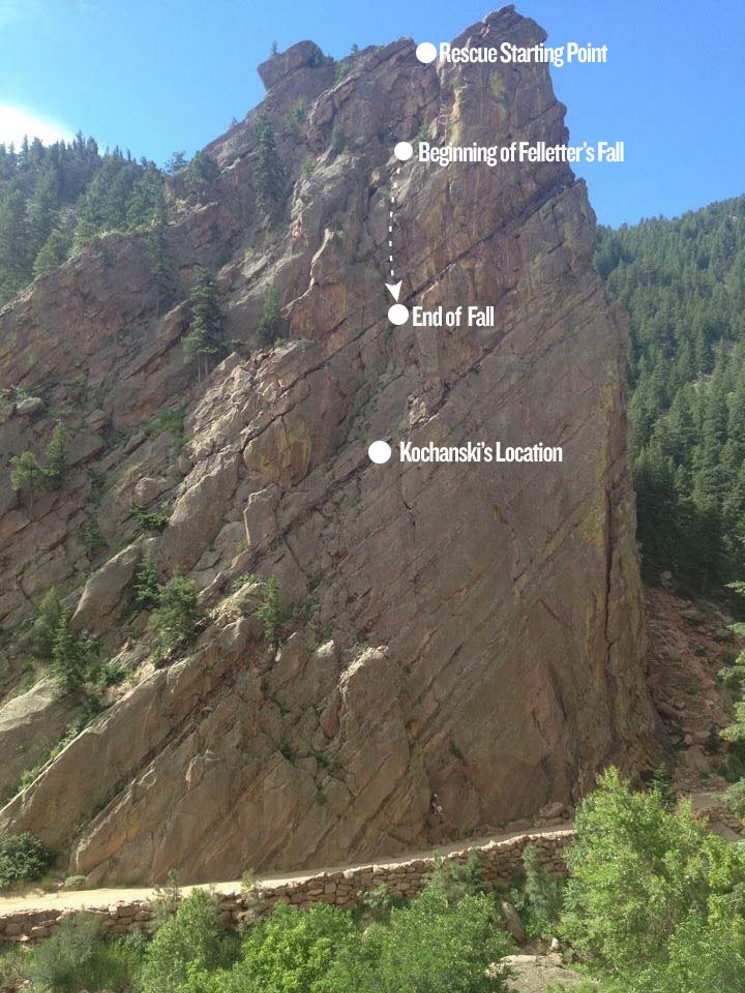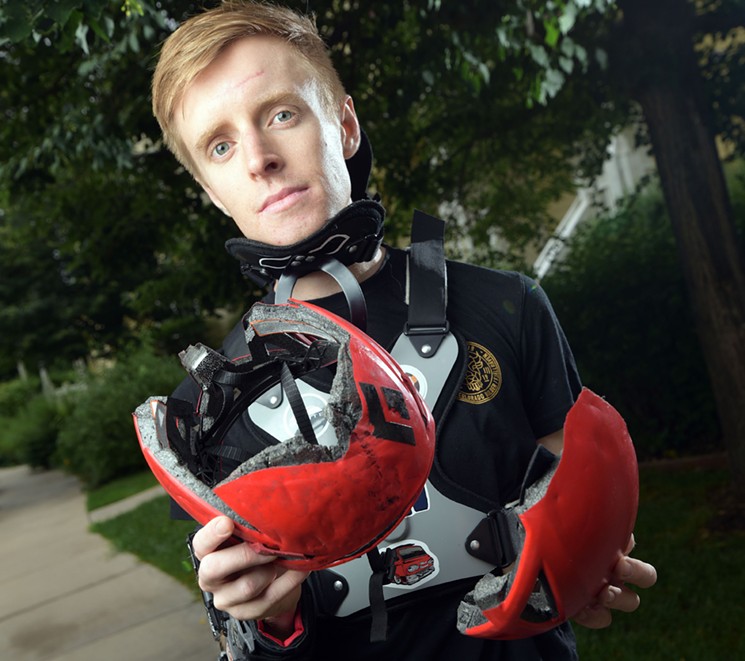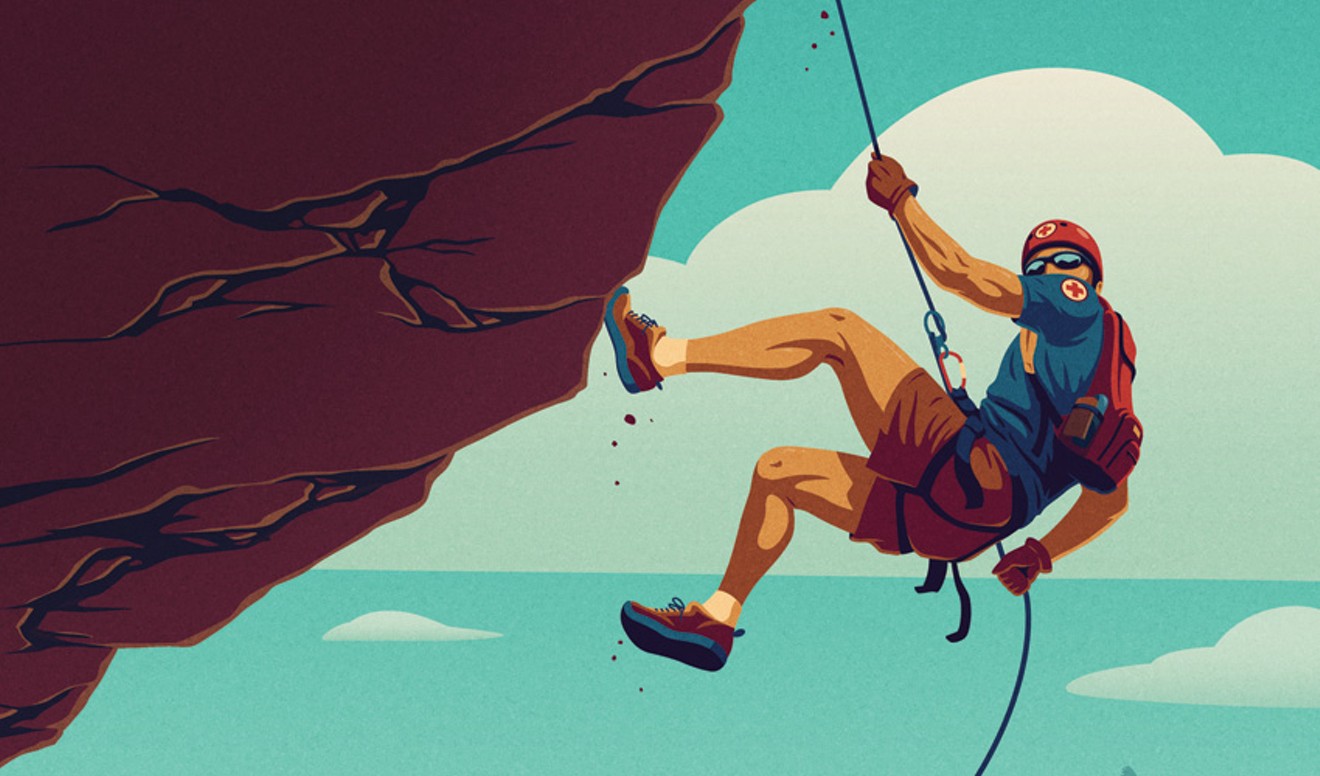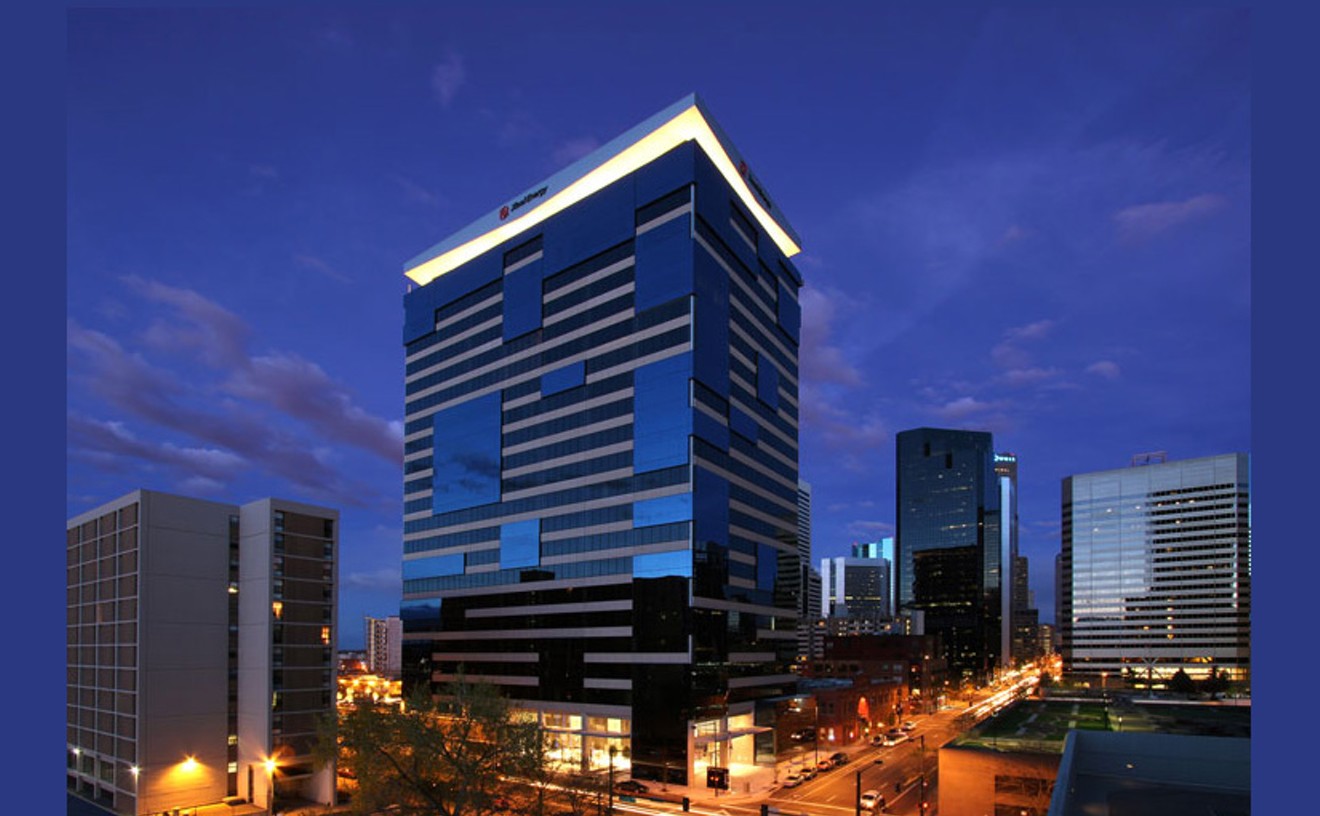The climber, a 27-year-old graduate student at the nearby University of Colorado Boulder, was in his element. Since getting into climbing in 2014, Conor Felletter had become quite the rock rat, reveling in the endless variety of climbs and geology in Boulder County and acquiring so much gear that the trunk of his Subaru Forester resembled an REI garage sale.
On this day, May 12, 2017, Felletter was in exceptionally high spirits. It was officially summer! He and his climbing partner, Kelly Kochanski, had just completed their spring semester at CU Boulder and had raced to Eldorado Canyon as soon as Kochanski, who was graduating, finished with her commencement ceremony and swapped her dress for leggings and a climbing harness.
It was warm and sunny, the perfect climbing weather. When Kochanski and Felletter arrived at “Eldo,” they found that the main crack on the Bastille (the Bastille Crack) was already occupied by other climbers. But they didn’t mind.
After leading the first ascent, or pitch, 150 feet up, Felletter decided he’d set up protective gear on a second pitch slightly to the left of the crack so that his rope wouldn’t tangle with those of other climbers.
Climbing the second pitch was easy, at least for Felletter. When he reached the top, he spotted a suitable place to set up an anchor, which would secure the top of his rope to the rock so that he and Kochanski could scale up and down the climb he’d just led. Felletter tugged on the rope, a signal to Kochanski, who could no longer see him from her belay spot below, to dole out slack so that he could loop the rope through the anchor. Feeling secure with three points of body contact on the rock, Felletter inserted the first piece of the anchor — a spring-loaded contraption known as a camalot, or cam — into a crack. Feeling balanced and not wanting to waste any time, he elected not to clip his rope through the first cam, and instead set about inserting a couple more cams before he clipped in.
That was when Felletter felt something shift beneath his feet. The next thing he knew, he was plummeting through the air.He didn’t scream. He completely succumbed to gravity, tumbling down the side of the cliff.
tweet this
He didn’t scream. He completely succumbed to gravity, tumbling down the side of the cliff. By the time Kochanski spotted him and frantically tightened the rope, Felletter had already flipped upside down. His nosedive continued until he slammed headfirst into a bulge protruding from the cliff, the force of the impact enough to break his helmet into two pieces. Blood squirted from his head.
He had fallen more than forty feet.
To Kochanski’s horror, Felletter then went completely limp. Everything had happened so fast. Now her friend was hanging, seemingly lifeless, on a rope hundreds of feet up the side of a cliff.
She began yelling, “Fallen climber! Fallen climber! Somebody help!”
Within an hour, the Rocky Mountain Rescue Group would be on the scene.

Conor Felletter sustained serious injuries from his fall in Eldorado Canyon.
Courtesy of Conor Felletter
The team, made up of 75 volunteers, responds to calls for everything from hikers with sprained ankles and fallen rock climbers to avalanches and downed aircraft.
It’s no coincidence that such an experienced group is based in Boulder, whose county encompasses some of the most diverse topography in the nation. Eldorado Canyon, in the southern part of the county, is a mecca for rock climbers. Farther north is Boulder Canyon, a popular spot for hiking, rafting and climbing. The county extends all the way west to the Indian Peaks Wilderness, which straddles the Continental Divide, the demarcation in the Rockies that divides water flow to the Pacific Ocean on the west side and the Atlantic Ocean on the east. Even within the city limits of Boulder, there are three 8,000-foot peaks as well as giant rock slabs — the most distinguished of which are the Flatirons, so named because they each resemble the bottom of a clothes iron. The Rocky Mountain Rescue Group serves this entire region.
The group got its start soon after the end of World War II, when climbing and backpacking were becoming more common and hundreds of trained climbers with the Army’s Colorado-based 10th Mountain Division returned from fighting overseas.
RMRG was also a response to tragic incidents that occurred during the winter of 1946-47. They began with three climbing fatalities on the Third Flatiron, for which a local professor and climber named Harold Walton was recruited to recover the bodies. Then, in December 1946, three students who were part of CU Boulder’s hiking club attempted a winter summit of the 13,409-foot Navajo Peak near the Continental Divide. They fell while roped together during a descent on a snowfield. One of the students was killed when he slammed into some rocks. It took volunteer searchers organized by the Boulder County Sheriff several days to find the deceased student and the two survivors, one of whom died a week later in a hospital. They might have been found much sooner had an experienced search-and-rescue team led the recovery effort.RMRG was a response to a series of tragic incidents that occurred during the winter of 1946-47.
tweet this
The final straw came after a three-year-old girl named Alice wandered from her home during a snowstorm on January 27, 1947. When Alice’s body was discovered the next morning, curled up underneath a bush only a mile from her home, there were tracks in the snow made by members of a hastily organized search party five feet from where she had died.
A community meeting was called to discuss forming the Boulder Rescue Group — what would later become Rocky Mountain Rescue Group — just days later, according to the Boulder Daily Camera. RMRG has been answering calls in Boulder County — and beyond, when it assists other rescue groups — ever since.
Today, RMRG responds to about 200 calls a year on average, which is among the most — if not the most — of any SAR team in the United States. Around a third of the calls are “incidents,” meaning that the calls are false calls or that victims are able to help themselves to safety. But RMRG conducts dozens of organized searches every year and even more technical rescues. Those calls become “missions,” during which life-or-death situations are not uncommon.
RMRG also specializes in locating and recovering victims from downed aircraft, with a number of dramatic examples members can point to over seventy years. In 1948, RMRG recovered bodies from a C-47 twin engine airplane that crashed into Niwot Ridge. In 1956, RMRG members traveled to Arizona to assist with hauling wreckage and the remains of 128 bodies from a horrific mid-air collision of TWA and UAL airplanes over the Grand Canyon. In 1970, the group responded when a plane carrying football players from Wichita State University crashed near Loveland Pass, killing thirty of the forty passengers.
Boulder County Sheriff Joe Pelle calls the work of RMRG “critical.”
“There’s a state statute that makes the sheriff responsible for search-and-rescue in the county,” Pelle explains. “It says that we have to coordinate efforts and make use of the resources available to us, and we do that by our contracts with volunteer search-and-rescue agencies like Rocky Mountain Rescue, Boulder Emergency Squad and Longmont Emergency Unit.
“Rocky Mountain Rescue does all of the technical rescues for us, as well as a ton of searches,” he continues. “To me, the missions that are the most impressive are the high-angle rescues with rappels, but the ones that are the most taxing are the searches for lost souls that can take a week or more. It’s really those multi-night and multi-day missions that I appreciate them for, because it’s a tremendous commitment for volunteers to be making. In that way, they’re an invaluable help, a great partnership and a long professional friendship.”
After the initial shock of seeing Felletter slam headfirst into a rock and then go unconscious, Kochanski was relieved to see him stir after a few moments. He motioned for her to lower him to a ledge.
Kochanski couldn’t tell how serious Felletter’s injuries were; she couldn’t reach him without going off belay, which she did not feel safe doing.
A nearby climber — Athena Vasquez, who was visiting from California — was able to reach Felletter and help stabilize him on the ledge, which sloped precariously at about thirty degrees. Felletter was aware enough to ask her to hold his head steady. “My neck hurts,” he said, drifting in and out of consciousness. Vasquez called 911.
When someone calls 911 to report a mountain emergency in Boulder County, the call is routed through the Incident Command System, which is a regimented chain of command that loops in the Sheriff’s Department and all relevant agencies and volunteer groups, including RMRG. All RMRG members carry a radio/pager that alerts them to calls, and at RMRG’s headquarters near downtown Boulder, the team keeps four-by-four trucks stocked with a variety of specialized mountaineering and rescue equipment that certain volunteers are trained to drive (other group members head to calls in their own vehicles).
Kevin Harner and Chris Wentz were closest to headquarters when the call about Felletter’s accident came in. They hopped into a truck and sped off toward Eldorado Canyon. Because it was graduation weekend at the university, traffic was extremely congested, but they were able to part the sea of cars by turning on the truck’s lights and sirens.
“This is 1933, acknowledging for Rocky Mountain Rescue,” Harner said, citing his code name on a radio channel where other emergency agencies were coordinating a response to the call.
During the rest of the mission, Harner would serve as RMRG’s “qualified” member, organizing the group’s response and keeping tabs on the members and what roles they were performing. (This responsibility is cycled on a preset schedule among certain group members.)
When Harner and Wentz arrived at Eldo, they found another member, Adam Fedor, already waiting for them. Because Harner had to coordinate the radio chatter, Wentz and Fedor immediately scrambled to the top of Bastille; from there, they would rappel to Felletter and assess his condition.
It was decided that Wentz, being a trained medic, would be the first to rappel to Felletter, on a 200-foot rope. He had an additional 200-foot rope with him in case he found that Felletter was close to death and needed to be evacuated to the road below. In that scenario, he’d hoist Felletter onto his back, attach the additional rope to the one already anchored at the top of Bastille, and continue his rappel to the canyon floor.
When Wentz conducted a medical assessment of Felletter, he found that he was stable enough that it was not worth the risk of moving his spine, which could cause paralysis if there was any spinal cord or vertebrae damage.
On the ledge with Vasquez and Felletter, Wentz noticed a chilling amount of blood, maybe ten feet of it, dripping down the rock face from the spot where Felletter had hit his head. As Wentz did a head-to-toe check of Felletter, he found only one serious laceration that the blood could have come from — on the climber’s forehead — and it had mostly clotted. He also felt for any cracks in the climber’s skull, as well as for signs of internal bleeding in areas like the pelvis, which can cause septic shock.
“He’s a trauma yellow,” Wentz reported on his radio, meaning that death was not imminent (that’s a trauma red) but that the climber’s injuries were still quite serious.
“It was clear to me that he was pretty injured and had spinal injuries,” Wentz recalls. “He needed a vertical evacuation.”
To avoid any further spinal damage, the vertical evacuation, which would involve getting Felletter off the rock face on a litter, would need to be carried out by multiple RMRG members.
At that point, Wentz could relax slightly; he knew that numbers and expertise wouldn’t be a problem. Already, more RMRG members who were trained for exactly this kind of delicate procedure were staging for a vertical evacuation from the top of Bastille.
When it comes to missions like vertical evacuations, Rocky Mountain Rescue Group’s reputation for expertise extends far beyond Boulder County.
Charley Shimanski, an expert on all things search-and-rescue — having served as the president of the national Mountain Rescue Association, as well as being a current member of the Alpine Rescue Team in Evergreen and volunteer coordinator for the helicopter program Flight for Life — calls RMRG one of the “most qualified teams in the country.”
“If I were ever in a world of hurt in Boulder County and the person coming to my aid had a Rocky Mountain Rescue sticker on their helmet, there would be as big a smile as I could muster on my face, knowing that I’m in good hands,” he says.
RMRG is one of about 100 teams that are accredited through the national Mountain Rescue Association. What that means, Shimanski explains, is that “every five years, accreditation testers, including from the Alpine Rescue Team, will descend on Boulder for three days and throw scenarios at Rocky Mountain Rescue.”
The group being tested gets no warning about the kinds of tasks it’ll be asked to perform.
“We’ll set up scenarios, and we’ve got all sorts of evaluators in bright-green vests that study everything that team members do — every rope they choose, every knot they choose, everything about the technical setup — and we evaluate throughout the day,” Shimanski explains. “And it’s not a rubber stamp. Teams do fail.”
The accreditation means the rescue group can be trusted to the highest degree. “When I go to Boulder and I’m on a joint mission, and there’s a rescuer with Rocky Mountain Rescue I’ve never seen before, and they hand me a rope and say, ‘Here, I’ve safetied this. Hang your ass off of it and rappel 2,000 feet down to our subject,’ if that person has a Mountain Rescue Association patch on their jacket, I know that they’ve been through an accreditation, and I don’t have to check their knots or question their system,” says Shimanski. “That patch is like M.D. at the end of someone’s initials. I know how much they’ve been through in terms of training.”
RMRG’s hierarchy is clear-cut. At the bottom are “prospectives” — individuals interested in joining the team who attend trainings but have not yet been voted into the group. Then there are “supports,” or team members who are directed to perform different tasks in the field during missions. “Qualifieds,” or “Qs,” coordinate the logistics of a mission, such as when Harner manned the radio during the Felletter mission. And finally, leading missions in the field are the “Rescue Support,” or “RS,” members of the team.
Making the jump from a support to an RS is a significant achievement, and RMRG likes to keep the test to become an RS something of a secret.
According to member Drew Hildner, “Becoming an RS is kind of like being kidnapped for a very technical hazing. You get taken out to the woods and get a bunch of technical problems thrown at you, and a lot of times they just kind of mess with you — just to rattle your head.”
For example, Hildner says, sometimes the RS test involves being asked to perform tasks that are physically impossible — like when evaluators remove essential climbing gear from a harness piece by piece and continue to ask its wearer to build rope systems or do technical hauls.
“They want to see how you fail,” says Hildner.“They want to see how you fail.”
tweet this
Hildner got involved with RMRG in 2003, when he was 25, and was voted in as a member in 2004. He remembers the missions being thrilling when he started.
“After one or two meetings, I was hooked,” he recalls. “During those first years, I would look at the forecast and see nice weekends coming up, and I made sure I didn’t have any plans I couldn’t cancel that would put me out of a position to be able to respond to calls.
“But it’s not rushing into burning buildings or whatever the mountain-rescue equivalent of that is, hanging off of ropes and grabbing damsels in distress,” he adds. “It’s putting in a lot of work and paying attention to pretty boring stuff. But that all has high consequences.”
Hildner estimates that he’s participated in approximately 500 rescues and that he’s volunteered 4,000 hours to the team. He’s also taken on different roles, including as the group’s recruitment chair, so he’s had various vantage points from which to examine the team’s culture.
When he joined, Hildner remembers being intimidated.
“For me, what was intimidating was the institutional knowledge,” Hildner says. “You have these older members who can look at a map if we were looking for a lost party and they’d put their finger somewhere and say, ‘We should send some people there.’ And it’d be against all search theory to do that, but we’d send two members there, and fifty-fifty we’d find them. That’s because they’d done this for decades, and for me, it engendered a lot of respect.”
The team’s battle-hardened and innovative spirit is apparent even outside of rescues. When he first started, Hildner would look at older guys like “Big John,” a quiet blue-collar type who always sported a long handlebar mustache and a tool belt, and marvel at how he could do things like rebuild a carburetor in negative temperatures with his bare hands.
Hildner admits that it wasn’t always easy when he was 25 to be acknowledged by the older members or to break into conversations with them.
He remembers going to one training and attaching a piece of tape with his name on it to the front of his T-shirt. Older RMRG members started addressing him by his name.
“Oh, yeah, I’m getting somewhere!” Hildner thought.
But the moment he took off the piece of tape, some of the same group members forgot his name and were saying, “Hey, YOU!”
“Later, I made a point of telling people, ‘Hey, this happens,’” Hildner recalls of his time serving as recruitment chair. “The culture is not meant to cut people out. It’s just that this is a very demanding group.”
Prospectives must take classes in the fall to join the team. Members teach, and then test for, various skill sets — things like compass reading, knot tying and how to assemble and pack gear. Some members estimate that only 20 percent of prospectives make it all the way through the training and eventually get voted into the team as a support.
Hildner says that members aren’t merely assessing whether a prospective has the technical know-how to start going on missions.
“We really talk about the person’s personality and their ability to accurately assess safety,” he says of the voting process, which is done behind closed doors. “We ask, ‘Do they know their limits?’ Because there are folks who show up with technical skills but with more of a John Wayne personality, and they don’t get voted in.”
Jonathan Horne has been on the team since 1996 and was group leader from 2003 to 2005. “The idea of riding in on a helicopter or doing cliff hangs gets dispelled pretty early on,” he says. “It’s not like you’re Sylvester Stallone out there.”
Still, Horne says that going on rescues, especially during his early years with the group, is addicting in its own way. RMRG introduced Horne, a city kid from Boston who moved to Boulder to attend CU in 1994, to a whole new world of outdoor activities.
“In those early days, I was perhaps too passionate about it,” he says. “I almost hate to admit this, but I’d have the option of going climbing or sitting around and waiting for [a rescue] to happen.” He’d usually choose the rescue, “which sounds crazy,” Horne acknowledges. “But you can predict when the weather’s nice and it’s summer that you’re going to get a call. So there’s a good chance you’ll have some impromptu adventure.”
Like all veteran members, Horne is a repository of incredible stories of loss, rescue and heroics. And like many members, he is also reserved about sharing them; RMRG’s volunteers don’t conduct rescues for self-aggrandizement or to regale dramatic stories to audiences at bars.
But Horne doesn’t shy away from talking about the most frightened he’s been during a rescue.
In March 2003, a massive blizzard that hit the Eldora ski area caused an avalanche, which covered the highway leading to the resort, trapping a few cars in the snow and stranding others trying to get down the mountain.
When Horne and other RMRG members arrived on the scene, they had to act quickly. Not only did they have to save the people trapped in their cars, but they had to deliver supplies to the hundreds of people stuck at Eldora Mountain — “everything from medicine to tampons,” Horne recalls. The problem was that the avalanche that covered the highway was still moving.
Nevertheless, RMRG members traversed the avalanche field to make rescues and deliver supplies.
“So you’re running across this length of snow with people on either side of you carrying probes and shovels, ready to dig you out,” Horne recalls. “As a rescuer, it’s unusual to be in a situation where you feel like you’re in danger, and it was probably the most scary situation I’ve been in.
“You also have a priority to take care of yourself and your teammates,” he adds.
Horne says that missions are sometimes called off or delayed when the situation is deemed too dangerous for rescuers, like during a thunderstorm. Risking a rescue at such times could create more victims.
At the same time, Horne says that it’s the involved and grueling missions that drive his commitment to the team. “It’s nice to think that it’s all completely altruistic — like, ‘Hey, I helped this guy and his life is saved as a result’ — but so many of the highs come from camaraderie,” he says. “You have these incredible experiences with your friends, like, ‘I just did this thing for someone else, and we did it together.’”
Despite the team being male-dominated — only fifteen of the 75 members are women — female members of RMRG also report the same feelings of camaraderie, albeit with some challenges that come from being around so much testosterone.
Eleanor Waxman, who joined the team in 2011, explains, “Most of the women on the team are used to being in male-dominated areas. A lot of them are scientists and engineers, in which case they’re used to being in situations that are 80 percent male. So in that sense, being on the team is not so different than being at work.”
Waxman herself is an example. She works in Boulder as a scientist at the National Institute of Standards and Technology. She sees a similarity in her field of work and RMRG: In both worlds, she has to speak up around her more aggressive male counterparts.
“Some of the women on the team tend to be quieter, and it can be hard to be heard,” says Waxman. “Guys will more often get picked for the exciting stuff like ascending up the Flatirons or being a vertical litter-bearer, and that’s probably a combination of guys being louder and volunteering to do it more assertively.”
But Waxman credits the team’s emphasis on merits and technical skills. “Because you have to get voted on by the entire group and show certain skill sets, there isn’t a questioning of your basic competencies [once you’re a member],” she says.
Even though there is always some good-hearted competitiveness among members, male and female, for the roles assigned during rescues, RMRG’s primary focus is on its “patients” and making sure their operations run smoothly and efficiently.
“Without a doubt, the sooner you can get to a call, the cooler job you’ll get,” Hildner explains, “and sometimes we’ll kind of race each other for positions. At the same time, you have to remember that it’s the [patient’s] emergency, it’s not your emergency. As soon as you can remember it’s not your emergency and that you’re going home tonight, you can kind of treat it like a math problem. Some people might think that’s kind of heartless. But if you can approach a mission like you’re solving for x — the variable — then it allows you to calm down, see things more clearly and take the blinders off.”
When it comes to technical rescues like Felletter’s, that kind of calculated approach is necessary.

A diagram of the Bastille shows where the accident occurred and how RMRG staged its rescue.
Courtesy of Conor Felletter
In Felletter’s case, RMRG decided it best to have team members rappel from the top of Bastille to him with a litter. They’d secure him in the litter and continue to rappel hundreds of feet to the road, where an ambulance would be waiting. Although a helicopter had been called for Felletter, it was waived off once it became clear that he was a trauma yellow and an ambulance would be satisfactory.
While RMRG’s rescues are free for their patients, ambulance and helicopter rides are typically handled by patients’ insurance companies and involve some out-of-pocket costs (from hundreds to thousands of dollars for an ambulance ride, and at least a couple thousand dollars for a helicopter ride), which can cause people to delay calling, in the hopes that their situation might change. But members of RMRG and Boulder Sheriff Joe Pelle stress that they’d like people who find themselves in serious situations to call for help as soon as they need it.“People often don’t want to call and inconvenience us and the rescue group, and so they’ll wait to call until things are pretty drastic.”
tweet this
“People often don’t want to call and inconvenience us and the rescue group, and so they’ll wait to call until things are pretty drastic, and at that point, it makes things much more difficult,” Pelle says. “We would much rather launch a search or rescue mission during the day with the sunshine than we would in the middle of the night.”
When two RMRG members reached Felletter, they lifted his body headfirst onto a litter using a hauling system that Wentz had constructed.
“Hey Conor, in a second or so you’re going to hear less, okay?” said one of the litter-bearers, Bijan Tuysserkani, to Felletter.
Tuysserkani and Wentz then used a device to pump air out of a full-body splint that rescuers call a “bean bag” surrounding Felletter’s body inside the litter. Once the air was removed, the bean bag formed a rigid splint around Felletter so that his body — especially his spine — would be less impacted by movement during the rest of the rappel.
Between the litter, Felletter and their own bodies, the litter-bearers were balancing a lot of weight. To make for a smooth rappel — especially because the rescuers had to navigate bulges and cracks and other abnormalities along the rock face — a separate team of RMRG members at the top of Bastille operated a brake system during the vertical evacuation. Using a dedicated radio channel, the team operating the brakes took radio commands from Tuysserkani about how fast to let out slack on the pair of 600-foot ropes attached to the litter team as it made its way to the canyon floor.
All the while, Tuysserkani did his best to keep Felletter conscious and engaged.
“You have to talk to the patient throughout the evacuation, because there’s this phenomenon when people survive for a while and then rescue comes and they think they can relax, and they die,” Tuysserkani explains. “So you don’t want that to happen, and I’ll say things like, ‘Hang in there — I know it’s hard, but it’s not over yet.’”
Felletter was promptly loaded into an ambulance and taken to Boulder Community Health Hospital. Only later, once reports came in from various doctors and surgeons, would the team learn just how close he had come to dying.
One reality of being on a search-and-rescue team is that members have to contend with death and tragedy.One reality of being on a search-and-rescue team is that members have to contend with death and tragedy.
tweet this
Stories involving death are, unfortunately, common. Hildner, a medic, remembers the first time he had to perform CPR on a mission, when he was called to Boulder Canyon to help a man who took a forty-foot headfirst fall right in front of his sister and his fiancée.
Upon reaching the man, Hildner saw that his chances of survival were slim. “His head was cracked open like a melon,” he recalls. “Even so, I got really hands-on, pushing a bunch of epinephrine, which makes the heart pump even when it’s low on blood. And I started seeing [him respond], and I was thinking, ‘We’re going to get him back!’”
But the man had already lost too much blood and was pronounced dead before he was loaded into a helicopter. Hildner was left at the scene, covered in the man’s blood, with his fiancée and sister.
“Several members have said that they’ll never forget their screams when they were told he was dead,” says Hildner.
“A part of me was disappointed that I’d let myself get so [emotionally] involved, knowing the statistics of traumatic [cardiac] arrests,” he continues. “I remember going home and sitting by myself for hours in the dark to process it. But the experience served me well two years later when I faced another traumatic arrest.”
Hildner explains that a lot of the first few missions for prospectives after they become supports involve body recovery.
“That’s really weird, because you join the group and you want to help people,” he says. “And the first thing you see is often a body, and it’s usually not a natural death.”
Because her husband, Steve, has been part of RMRG since 1995, when he joined at 21, Karyn Dundorf no longer frets about his safety during rescue missions, especially because he’s a competent climber and is surrounded during missions by exactly the people you’d want to have around in any dangerous mountaineering or climbing situation. But she has a hard time with the suicides.
“What worries me are the suicide calls, because those are the ones that stay on the psyche,” she says.
Steve admits that there was a period in 2015 when the amount of body recoveries RMRG did because of suicides got to him.
“In March and April of 2015, we had a string of calls about people jumping off cliffs, which was really unusual,” he says. “It was call after call, and it was a little over the top.”
Steve and Karyn credit members of RMRG for being supportive of each other after tough emotional missions.
“I think people are fairly open,” says Steve. “There might be other rescue agencies — like firefighters — who are a little more testosterone-driven, but definitely not on our team.”
He says it’s not unusual for group members to grab a beer or three after a body recovery and talk things out.
Still, suicide calls can weigh on people. Steve admits that he’ll sometimes look up the Facebook pages of people who died by suicide. “Some of it is curiosity — like, what was their life like before? What caused them to do this?” he says. “You want to have some kind of connection to them.”
It’s an unusually heavy burden for someone in a volunteer position to carry, and Kayrn does not mince words about boundaries she’s had to set with Steve in their relationship and family life. The couple has three children, all under ten years old, and Steve also works full time as an environmental engineer for the Department of the Interior.
Kayrn says there is a joke among some wives of RMRG members that they are the “widows of Rocky Mountain Rescue.” In fact, during one of Karyn and Steve’s first dates, in 2001, Steve’s pager went off when they were hiking, and he dragged her along while he conducted a rescue in Gregory Canyon.
“There certainly have been plenty of broken-up relationships from too much rescue,” Karyn says half jokingly. “But [Steve and I] have come up with a happy compromise: If he goes on a rescue, I get to take a different day off or take time to do something on my own” — an arrangement she’s shared with other spouses of team members.
Steve admits that, while he constantly puts pressure on himself to do more for the team, he’s cut the number of calls he goes on now that he’s a father, from about fifty a year when he started to about fifteen.
When asked whether it’s strange to commit so much to something he’s not paid to do, Steve says, “Occasionally when you help out in places like Rocky Mountain National Park, it is a little funky when you’re surrounded by guys from other agencies who are getting overtime, and you’re taking vacation time.
“But it’s also nice to know you’re doing it just because you want to be doing it,” he adds.
According to Kevin Harner, when RMRG was founded, right after World War II, it wasn’t just a response to Boulder’s need for skilled first responders; the organization grew out of a desire to support and give back to the local community. As other SAR groups were established throughout the country, they, too, were based on an all-volunteer model, and today that has become the national standard. “We like giving back to our community,” Harner says. “And financially, certain operations like searches, which can involve fifty, sixty or even seventy people, would be quite costly if we weren’t volunteers.”
Indeed, groups like RMRG are a boon to local governments, which don’t have to worry about paying personnel. The County of Boulder helps RMRG secure donations and grants that allow it to maintain its headquarters and purchase expensive gear.
“The county couldn’t afford to do this with full-time paid employees,” says Sheriff Pelle. “They’re the ones bringing in the good people and the good training.”
On the first Wednesday night following Felletter’s climbing accident in Eldorado Canyon, about fifty RMRG members reported to the group’s headquarters for its usual weekly meeting to go over trainings and upcoming events.
They also debriefed recent missions, and when it came time to discuss Felletter’s accident, Harner produced the helmet that unquestionably helped save the young man’s life.
As Harner separated the broken helmet, there was an audible gasp in the room.
“Here’s hoping that they’ll give him a new one,” quipped one member, referring to the helmet’s manufacturer.
“They should give him more than that,” another added.
But the team fell silent once Harner announced that a couple of Felletter’s family members had come to thank the group in person. Although such visits are rare, Harner says it means a lot to RMRG members when they can see the effects of their work.
Vince Felletter thanked the group, then provided an update on his son’s injuries.
Right after Conor was transported from Eldo to a hospital in Boulder, he was transferred to a spinal surgeon at Denver Health. He had broken three ribs and seven vertebrae and had torn the UCL ligament in his elbow.
“The spinal surgeon said that the [vertebrae] in Conor’s neck displaced and moved sideways, so normally when that happens, it pinches or cuts the spinal cord, which is either fatal or causes paralysis,” Vince told the group. “What happened to him is that, at the same time that the vertebrae [in his neck] displaced, it fractured. It actually broke that ring open. And that gave the spinal cord just enough room that it didn’t sever or pinch.Felletter had broken three ribs and seven vertebrae and had torn the UCL tendon in his elbow.
tweet this
“The spinal surgeon told us that Conor has no business being alive,” Vince continued. “I can certainly say that it was a miracle for us that you were there and did what you did, because there’s not a doubt in my mind you saved his life.”
The group then heard from Conor’s younger sister, Clare, his only sibling, who added, “For every one of you, because it could have been any one of you who got that call...I want you to know that the work you do is of such quality — I don’t know how you got him off that mountain without him being paralyzed in the process.”
In the weeks since that meeting, Conor Felletter has been a vocal advocate for RMRG, even though he’s still processing all of what happened during his accident on May 12.
Felletter is the first to admit that there are things he could have done differently when building the anchor at the top of the second pitch. “I could have clipped into that first cam,” he says. “That’s something that I’m going to have to consider going forward.”

Today, Felletter is recovering; he kept the helmet that broke into two pieces during his accident.
Anthony Camera
“It wasn’t a great time,” Felletter says.
But now that he’s come out of his hallucinations and is making progress with the brain injury, he’s making a speedy recovery.
“I got so lucky, and now I’m going to make the most of my life,” he promises. “I’d like to do my part to help fundraise for Rocky Mountain Rescue and to spread the word about wearing helmets and learning self-rescue techniques.
“I believe that having Rocky Mountain Rescue covering our back yard makes climbing in Boulder safer then anywhere else,” he adds. “It’s like having angels watching over us.”
Felletter says his accident gave him a greater appreciation for risk and reward. Moving forward, he says, he will be more considerate of how his pursuits could affect his family.
He’s excited to get back “out on the rock,” even though doctors have told him he can’t climb for the rest of the year. He’s already bought a helmet to replace the one that broke during his fall.
But he’ll never forget what else saved his life that fateful day in Eldorado Canyon.
“Without that helmet and Rocky Mountain Rescue, I’d be dead, no questions asked.”

















